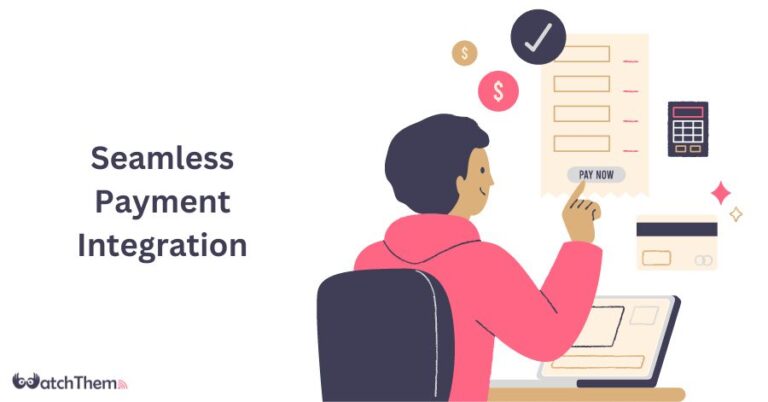Page Contents
As we navigate the dynamic landscape of modern business, the position of technology and innovative payment solutions keeps growing significantly. Among these, seamless payment integration has emerged as a critical element for operational efficiency and ensuring an accessible and satisfactory customer experience.
In this article, we delve into the pivotal role of seamless payment integration in modern businesses and its profound impact on delivering exceptional customer experiences.
The Importance of Seamless Payment Integration for Businesses
Seamless payment integration refers to merging numerous charge techniques into a unified system, easing the transaction for companies and their clients. Today’s business model needs companies to offer secure, short, and various price alternatives to fulfill consumers’ ever-evolving preferences. For similar information on how to gain this, traveling to this website can offer complete guidance.
Benefits of Seamless Payment Integration
It’s crucial to identify the tangible benefits of this integration, which can provide unprecedented value to businesses:
#1 Improved Customer Experience
Streamlined payment systems simplify transactions. By offering diverse payment alternatives and making sure of quick payment processing, businesses can significantly improve the customer experience, leading to patron satisfaction and loyalty.
#2 Increased Efficiency and Productivity
Seamless payment integrations can automate the payment process, increasing operational efficiency. These solutions reduce manual tasks and free up organizational resources, allowing businesses to focus on other essential aspects and directly contribute to productivity.
#3 Reduced Errors and Fraud
An integrated payment system minimizes the risk of errors and potential fraud. Automatic validation checks decrease the chance of failed transactions, double billing, and other discrepancies. Moreover, advanced security mechanisms can identify and prevent fraudulent activities, safeguarding the business and the customer.
#4 Enhanced Data Security and Compliance
Seamless integrations adhere to stringent data security protocols, such as Payment Card Industry Data Security Standards (PCI DSS). This compliance ensures that sensitive data is processed and encrypted securely, fostering customer trust and instilling a sense of reliability in your business processes.
Key Features of Seamless Payment Integration
Successful payment integration should incorporate these vital features:
#1 Multiple Payment Options
Having a variety of payment methods caters to the diverse needs of customers globally. From credit cards and e-wallets to bank transfers and mobile payments, a seamless payment system accommodates all, attracting a broader customer base.
#2 Payment Gateway Integration
A key to streamlining online transactions is the incorporation of robust payment gateways. These gateways provide a conduit between the e-commerce platform, customers, and financial institutions, enabling the secure transfer of monetary value.
#3 Automatic Payment Processing
In this fast-paced digital world, customers appreciate quick and automated transactions. Automatic payment processing and instant confirmations and notifications can enhance the overall transaction experience.
#4 Real-Time Transaction Tracking and Reporting
Seamlessly integrated solutions allow businesses to track transactions in real-time and generate comprehensive reports. These capabilities offer critical insights and analytics, facilitating informed business decisions and strategies.
Factors to Consider for Seamless Payment Integration
When planning for payment integration, the following factors require careful introspection:
Budget and Cost-effectiveness: The chosen solution should align with your business’s budget. Consider the cost versus the value derived, ensuring that the solution is cost-effective and offers good returns on investment.
Scalability and Flexibility: The system should scale as your business grows. It should handle increasing volumes of transactions and adapt to evolving payment technologies, including NFC and mobile payments, to ensure sustainable growth.
Compatibility with Existing Systems: Integration is meaningful only when it coordinates flawlessly with the existing infrastructure. Therefore, compatibility with current hardware or software platforms is crucial.
Compliance with Industry Regulations: You ensure that your chosen solution complies with industry and data security standards. Non-adherence can lead to severe penalties and reputational damage.
Examples of Successful Seamless Payment Integration
The real-world examples of Amazon, Uber, and Airbnb demonstrate the potential of seamless payment integration:
Amazon: Amazon’s ‘1-Click’ payment option is an excellent example of seamless payment integration. Customers can make purchases with just a single click, avoiding the need to re-enter payment details, which enhances the customer’s buying experience.
Uber: Uber’s seamless payment system enables automatic deductions at the end of each ride, making transactions effortless for customers.
Airbnb: Airbnb’s efficient integration of diverse payment methods enables it to effectively cater to a global audience. Various payment options and swift processing have contributed significantly to the platform’s success.
FAQs
In the following, we’ll answer some questions users face when learning about seamless payment integration:
Q1. What Is Seamless Payment Integration?
Seamless payment integration refers to the process of merging multiple payment methods into a unified system within a business framework. It aims to simplify transactions for both businesses and customers by offering various payment options and ensuring smooth processing.
Q2. What Role Does Data Security Play in Seamless Payment Integration?
Data security is a critical aspect of seamless payment integration as it involves the processing and handling of sensitive customer information. Integrated systems adhere to stringent security protocols such as PCI DSS to encrypt and protect data, thereby fostering trust and confidence among customers regarding the security of their financial transactions.
Conclusion
To recap, seamless payment integration is pivotal in modern businesses’ growth and customer satisfaction. Improved customer experience, increased efficiency, reduced errors, and enhanced data security are some of the many benefits one can enjoy.
Among key features, multiple payment options, payment gateway integration, and real-time tracking stand out, enhancing the overall business performance. While considering such integration, factors like cost-effectiveness, scalability, compatibility, and compliance should be at the forefront of my mind.
In conclusion, embracing seamless payment integration is no longer an optional strategy. Instead, it is a prerequisite for succeeding in the competitive business environment. As technology and e-commerce markets expand, businesses that adapt and align themselves with these trends will cement their position in the future business world.

